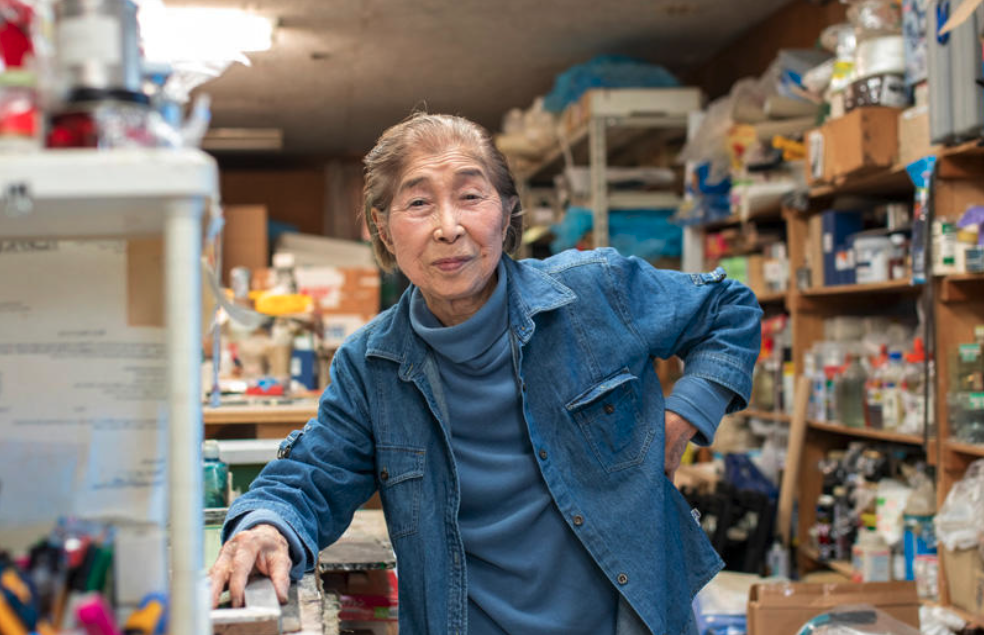News
Kimiyo Mishima, 1932–2024


On June 19, Kimiyo Mishima, a Japanese contemporary artist renowned for her ceramic sculptures, died at the age of 91. Infused with sardonic humor, Mishima’s practice commented on our gullibility and recklessness within an information-saturated society.
Born in Juso, Osaka, in 1932, as a child Mishima witnessed the devastation of World War II and remembered emerging from an air raid shelter to a city reduced to rubble. The traumatic experience and the ensuing chaos endowed Mishima with a “fear and anxiety of drowning in information”—a theme she persistently investigated in her paintings, collages, sculptures, photography, and installations.
Mishima began oil painting in high school under the tutelage of a painter from the Independent Art Society (Dokuritsu Bijutsu Kyokai), a pioneering Japanese collective who concentrated on yōga (Western-style painting). Upon graduation, Mishima relocated to Tokyo to pursue her artistic aspirations, where she experimented with still lifes and representational paintings. In 1952, she joined Atelier Montagne Youga Kenkyusho, an independent art association founded by the artist Shigeji Mishima (1920–1985), whom she would later marry. Within this intellectual milieu, Mishima discussed international art movements such as art informel, abstract expressionism, and pop art, which catalyzed her transition from figurative painting to abstraction by 1957.
Her ceramic sculptures were a result of the newspapers, magazines, and advertising flyers scattered across her studio floor, which she repurposed for her collage work. Mishima saw the accumulation of printed pages as a symbol of the ceaseless flood of information that overwhelms our everyday existence. The fragile and brittle material quality of ceramics also resonated with Mishima. By rendering waste paper as three-dimensional ceramic sculptures, she portrays the information we absorb as ephemeral and delicate. Not just a commodity or a detached occurrence, printed knowledge should be recognized for having tangible consequences—like ceramics, it demands careful handling.
Mishima crafted her signature “breakable printed matter” works (1971–2024) using self-taught silkscreen techniques. She subsequently began to create sculptures of empty beer cans, cardboard boxes, and other discarded objects, relics of consumer culture that reveal an unease with extravagant human consumption. In 2005, her large-scale sculpture Another Rebirth 2005-N was unveiled on Naoshima island in Kagawa Prefecture. The public art installation portrays a gigantic meshed wastebasket filled with discarded newspapers and food packaging, all crafted from ceramics.
Over the years Mishima had major solo exhibitions at Taka Ishii Gallery in New York (2016), Art Factory Jonanjima in Tokyo (2015), and Contemporary Art Museum in Ise, Mie Prefecture (2004), among other galleries and institutions both domestically and internationally. In 2021, she was featured in the Mori Art Museum’s survey “Another Energy: Power to Continue Challenging – 16 Women Artists from around the World.” Her works are included in the permanent collections of the Mori Art Museum, Tokyo; the Museum of Contemporary Art Tokyo; the National Museum of Art, Osaka; and M+, Hong Kong; Everson Museum of Art, New York; and the Korean Culture & Arts Foundation Seoul; among others.
In 1974, Mishima was the recipient of the gold medal at the International Ceramic Exhibition, hosted by the Museo Internazionale delle Ceramiche at Faenza, Italy. The artist’s retrospective “Mishima Kimiyo: Memories for the Future” will be on display at the Nerima Art Museum in Tokyo until July 7, 2024. A memorial service for Mishima was held by her family and close acquaintances.
Mioie Kwok is an editorial intern at ArtAsiaPacific.







